ID: Bacterial Growth
1/51
There's no tags or description
Looks like no tags are added yet.
Name | Mastery | Learn | Test | Matching | Spaced |
|---|
No study sessions yet.
52 Terms
most bacteria divide by the process of…?
binary fission
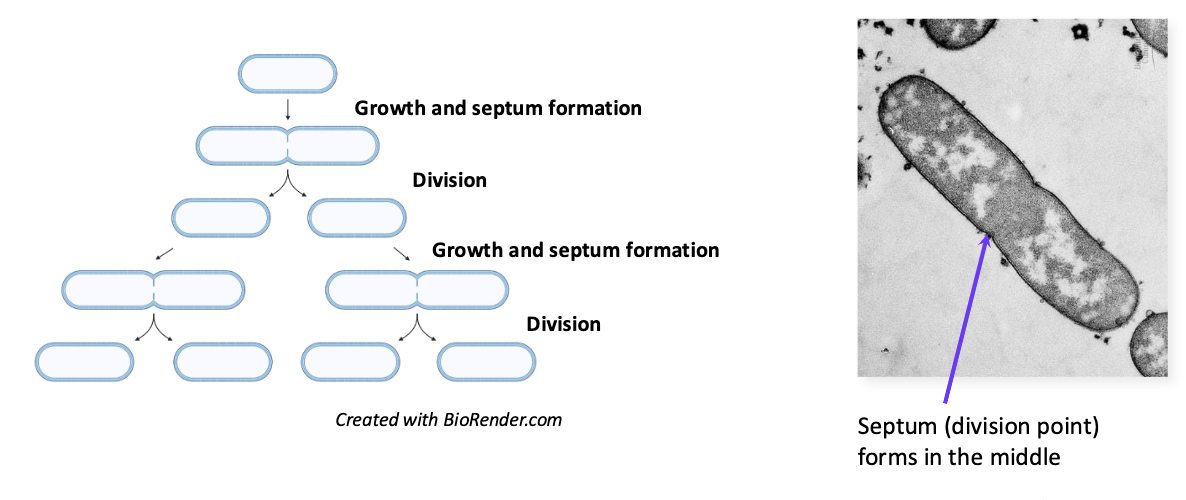
during binary fission, what is the division point that forms in the middle called?
septum
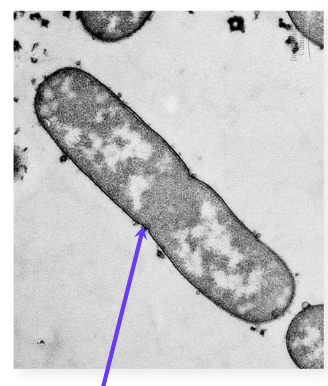
A bacterium dividing every 30 minutes would produce a mass as large as that of the Earth (6 x 1024 kg) in __ days
2.5
bacterial growth is linear/exponential
exponential
what are the phases of bacterial growth in liquid culture?
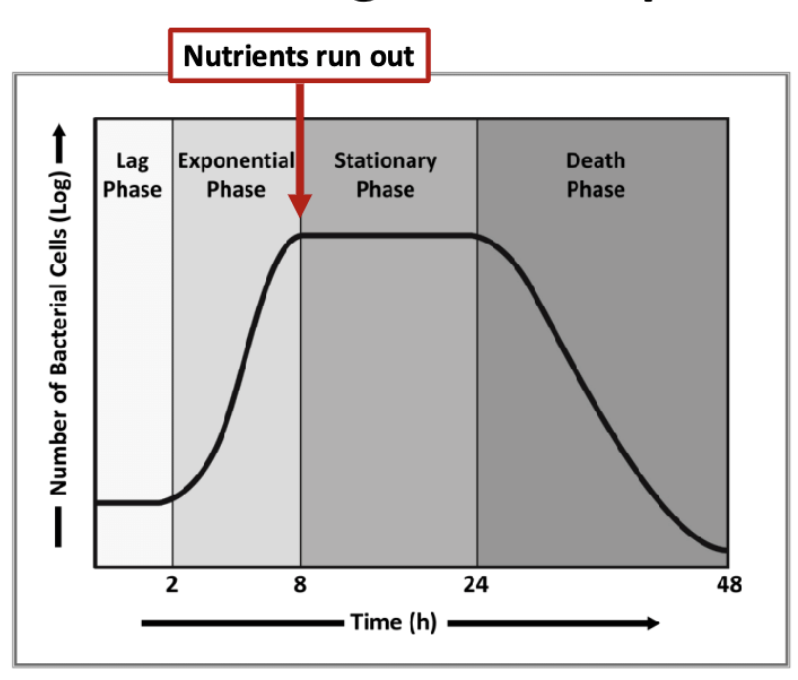
what factors control bacterial growth?
temperature
nutrients
pH
oxygen
what are the categories of bacteria that demonstrate that they can grow in a wide range of temperatures?
psychrophiles = permafrost, glacier, deep oceans, fridge
mesophiles = human pathogens
thermophiles = hot tubs, sources of laundry enzymes
hyperthermophiles = sources of heat-stable enzymes for PCR
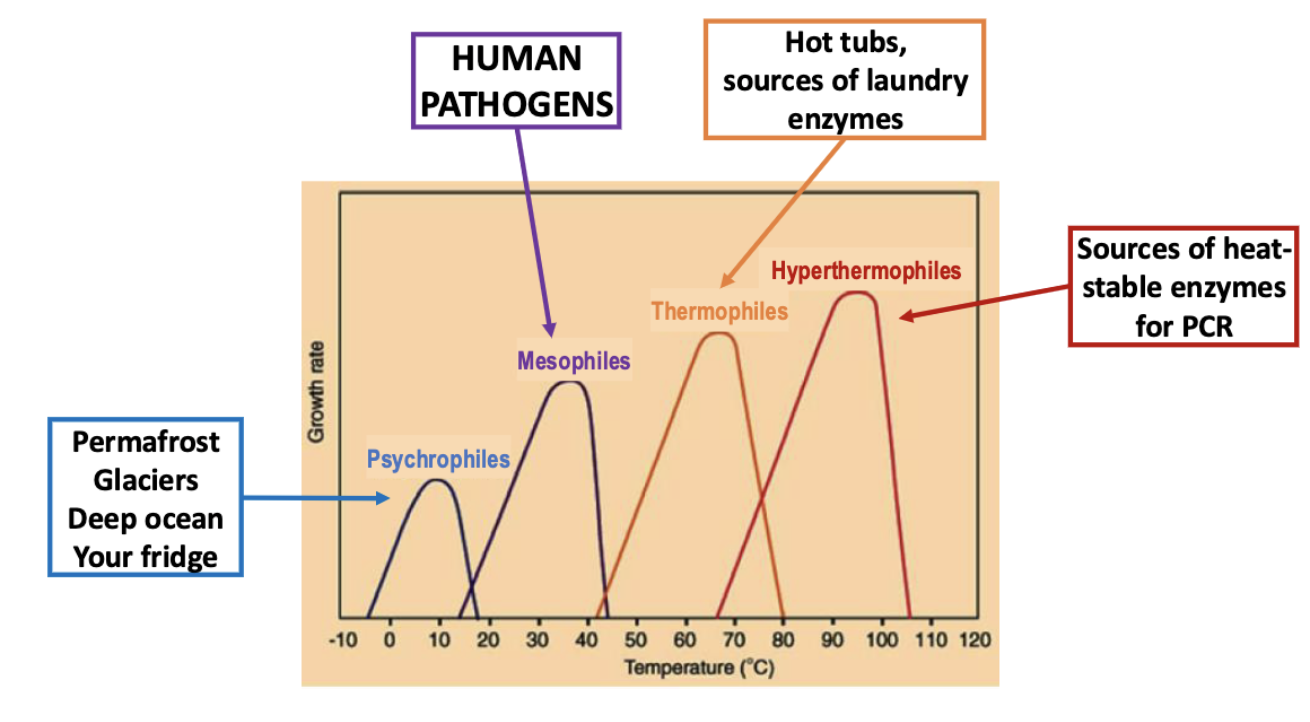
what are challenges/solutions faced by thermophiles and hyperthermophiles?
challenges: protein denaturation and structural damages
solutions: heat-stable proteins, saturated fatty acids in memrbanes
what are challenges/solutions faced by psychrophiles?
challenges: reduced enzyme activity and membrane fluidity
solutions: cryoprotectants inside cells, unsaturated fatty acids in membranes
what is a minimal medium?
a basic bacterial growth diet, typically contains a single carbon source and mineral salts
what are possible ingredients of a minimal medium?
carbon (glucose, sucrose, lactose, etc.)
mineral salts
nitrogen (NH3, NO3-, amino acids)
sulfur (SO4 2-)
phosphorus (PO4 3-)
cations and anions (Mg2+, Mn2+, Ca2+, Zn2+, Fe2+, Cl-, etc.)
what kind of bacteria does not need a carbon source in their minimal medium (an exception to the single carbon requirement for growth)?
photosynthetic bacteria (can make their own carbon compounds from CO2)
do bacteria need vitamins?
yes, they can make them (for themselves and for us)wh
what are prototrophs?
bacteria that CAN grow in a minimal medium (a single carbon source and mineral salts)
what are auxotrophs?
bacteria that CANNOT grow in a minimal medium
cannot synthesize an important nutrient they need to grow (amino acid, nucleotide bases or vitamin)
must get from environment (must live in environemtn where nutrient is always present)
what are the categories of bacteria that demonstrate they can grow in a wide range of pH?
acidophiles
pH <4
mining areas, geothermal vents, acidic soils
neutrophiles
pH 6-8
human body
alkaliphiles
pH >9
industrial plants, insect hindguts, soda lake
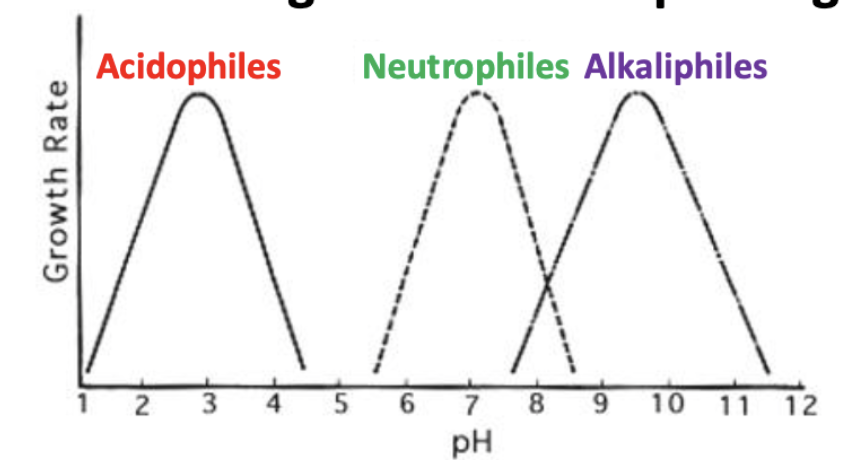
what are benefits to being an auxotroph?
don’t need to expend energy making a nutrient that they can just get from the environment
Regardless of the external pH, the pH INSIDE the cell is always…?
neutral, pH = ~7
what are the categories of bacteria that demonstrate they can grow in a wide range of oxygen levels?
obligate aerobes
need O2
obligate anaerobes
grow only without O2
facultative anaerobes
grow with or without O2

which test tube demonstrates what type of bacteria (in terms of oxygen requirement)
obligate aerobes
obligate anaerobes
facultative anaerobes
what type of oxygen requirement bacteria would be found in lungs? (don’t need to memorize examples)
obligate aerobes
Mycobacterium tuberculosis*
Pseudomonas aeruginosa*
Bordetella pertussis*
what type of oxygen requirement bacteria would be found in digestive tract? (don’t need to memorize examples)
obligate anaerobes
Porphyromonas
Actinomyces
Bacteroides
Clostridia
what type of oxygen requirement bacteria would be found everywhere in body? (don’t need to memorize examples)
facultative anaerobes
Staphyloccocci*
Streptococci*
Escherichia coli*
Salmonella
Listeria
TRUE or FALSE?
Bacteria can grow only at physiological temperatures.
FALSE: Bacteria can grow only at physiological temperatures.
T/F: The pH inside the bacterial cell is the same as the pH outside.
FALSE: The pH inside the bacterial cell is the same as the pH outside.
T/F: Aerobic bacteria need oxygen to grow.
TRUE: Aerobic bacteria need oxygen to grow.
T/F: Human pathogens are typically mesophilic acidophiles
FALSE: Human pathogens are typically mesophilic NEUTROphiles
bacteria also need fuel (ATP). what are the 2 processes by which they can make it?
respiration (oxidative respiratory phosphorylation)
fermentation (substrate-level phosphorylation)

what is respiration (oxidative respiratory phosphorylation)?
Electron carriers NADH or FADH2 are oxidized by O2 to produce ATP
via electron transport chain (ETC)
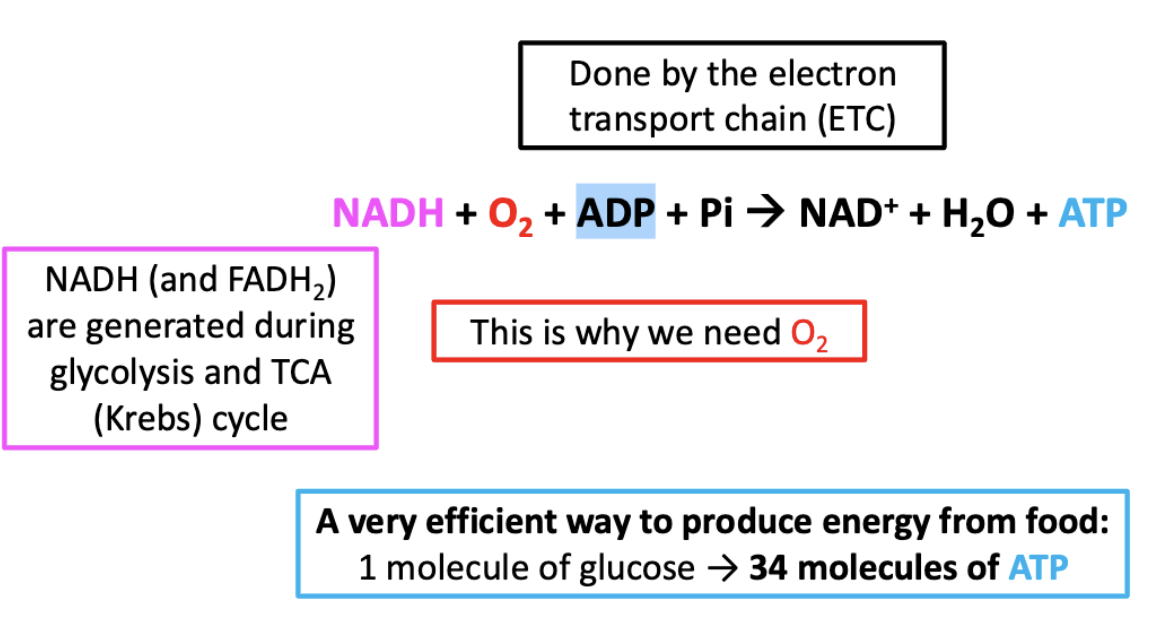
during respiration (oxidative respiratory phosphorylation), 1 molecule of glucose can produce how many molecules of ATP?
34 molecules (very efficient)
NADH and FADH2 that is used during respiration (oxidative respiratory phosphorylation) are generated during what process?
glycolysis and TCA cycle
the electron transport chain (ETC) consists of…?
membrane-bound oxidases
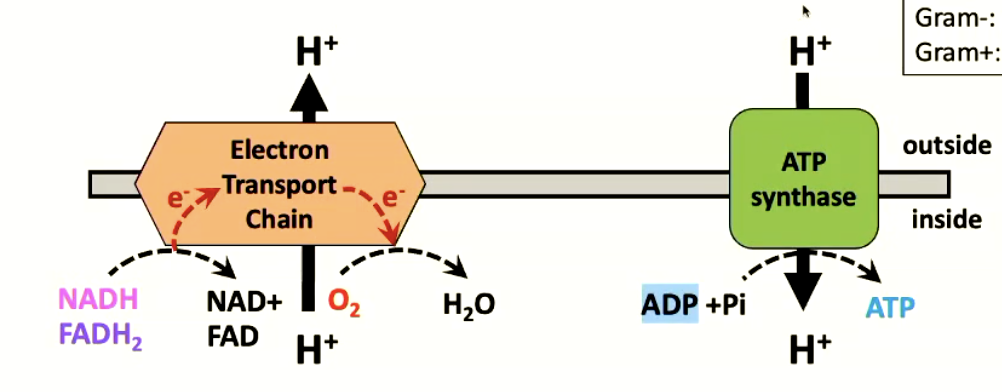
in the electron transport chain (ETC), what are the electron sources that provide the “reducing power”?
oxidation of NADH (or FADH2)
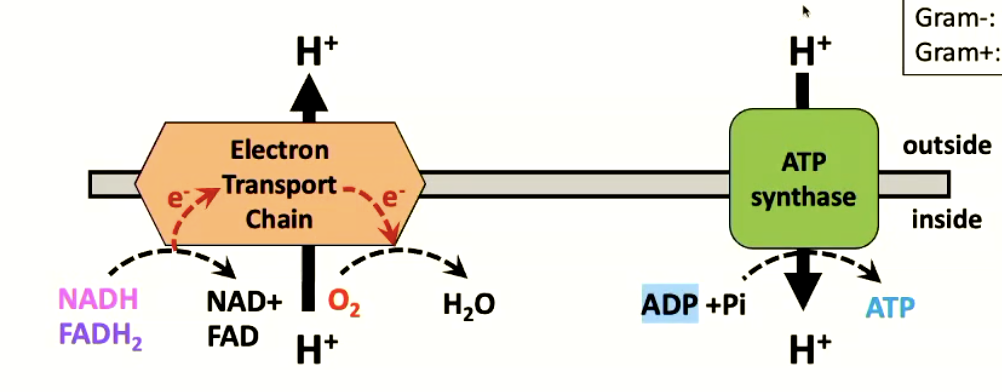
in the electron transport chain (ETC), what is the terminal electron acceptor?
O2 (to form water)

describe the process of the electron transport chain (ETC).
oxidation of NADH (or FADH2) = electron source that provides reducing power
electron accepted by O2 (terminal electron acceptor) to form water
proton gradient generated
ATP synthase then uses the proton motive force generated by ETC to make ATP
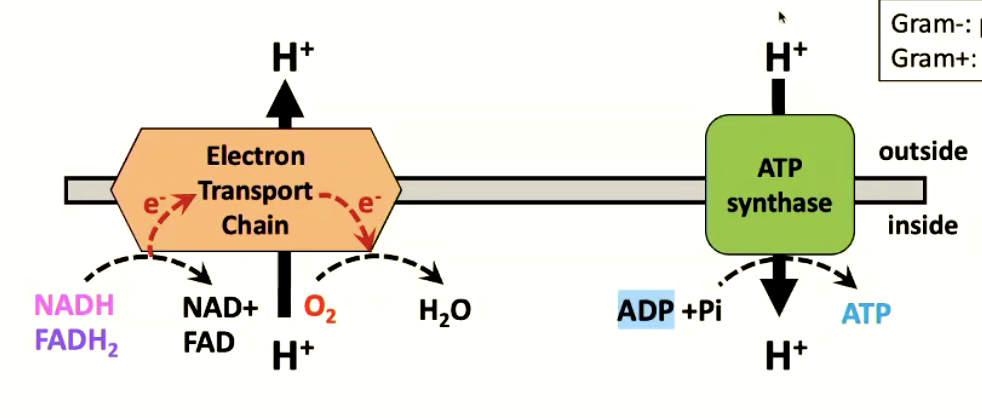
what enzyme uses the proton motive force generated by ETC to make ATP?
ATP synthase
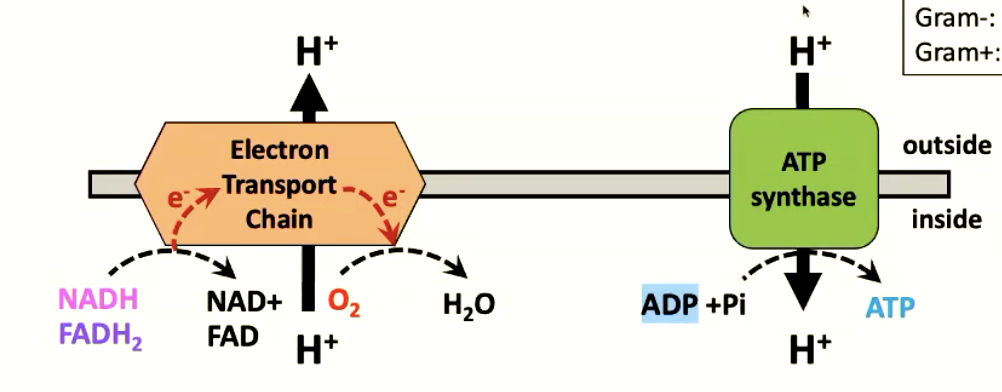
in gram(-) bacteria, where does respiration occur? what about in gram(+)?
gram(-) = periplasmic space
gram(+) = outside membrane
t/f: respiration can be aerobic or anaerobic.
true. in aerobic conditions, O2 acts as a terminal electron acceptor (but what about in anaeorobic conditions?)
how does respiration work under anaerobic conditions?
Anaerobic respiration uses terminal electron acceptors other than O2
fumarate
No3-
SO4 2-
S
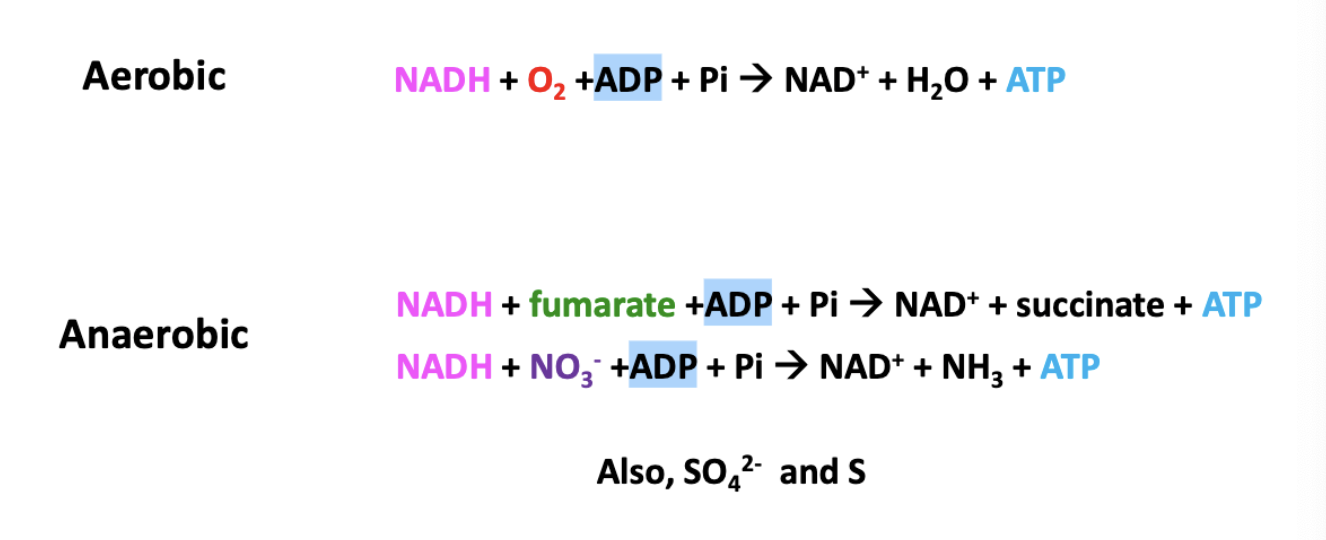
is fermentation aeorbic or anaerobic?
anaerobic (O2 not needed)
is respiration aeorbic or anaerobic?
can be either!
how is ATP synthesized during fermentation (substrate-level phosphorylation)?
ATP is synthesized by direct transfer of phosphate group from a substrate (X) to ADP
produced reducing power (NADH, FADH2)

during fermentation (substrate-level phosphorylation), 1 molecule of glucose can produce how many molecules of ATP?
4 molcules of ATP (not an efficient way to produce energy from food)
fermentation (substrate-level phosphorylation) occurs during what processes?
glycolysis and TCA cycle
which energy producing process consumes reducing power (NADH, FADH2)? what produces reducing power?
respiration = consumes reducing power
fermentation = produces reducing power
Bacteria can produce ATP under aerobic conditions (i.e., in the presence of oxygen) by which of the following mechanisms?
A. oxidative phosphorylation using oxygen as a terminal electron acceptor (a.k.a. aerobic respiration)
B. oxidative phosphorylation using fumarate as a terminal electron acceptor (a.k.a. anaerobic respiration)
A. oxidative phosphorylation using oxygen as a terminal electron acceptor (a.k.a. aerobic respiration)
Bacteria can produce ATP under aerobic conditions (i.e., in the presence of oxygen) by which of the following mechanisms? List all TRUE answers.
A. oxidative phosphorylation using oxygen as a terminal electron acceptor (a.k.a. aerobic respiration)
B. oxidative phosphorylation using fumarate as a terminal electron acceptor (a.k.a. anaerobic respiration)
C. substrate-level phosphorylation reactions of the glycolytic pathway and TCA (Krebs) cycle (a.k.a. fermentation
A and C
how does streptococcus mutans cause tooth decay?
produce a lot of acid
makes sticky biofilm
what are some characteristics of streptococcus mutans?
common oral bacterium
gram(+) coccus
facultative anaerobe
why does S. mutans produce a lot of acid?
S. mutans lacks ETC so it cannot use respiration to produce ATP. Therefore, ATP is generated solely by fermentation. Excessive fermentation produces a lot of acid (lactic acid, specifically) which causes demineralization of enamel.
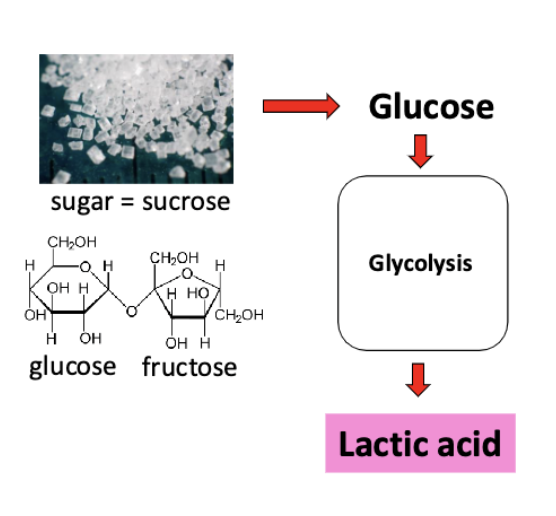
how do S. mutans generate biofilms?
S. mutans glucosyltransferases produce lactic acid but also produce long-chain glucans (aka mutans). These glucans are sticky and help form biofilms on tooth surface which causes plaque formation.
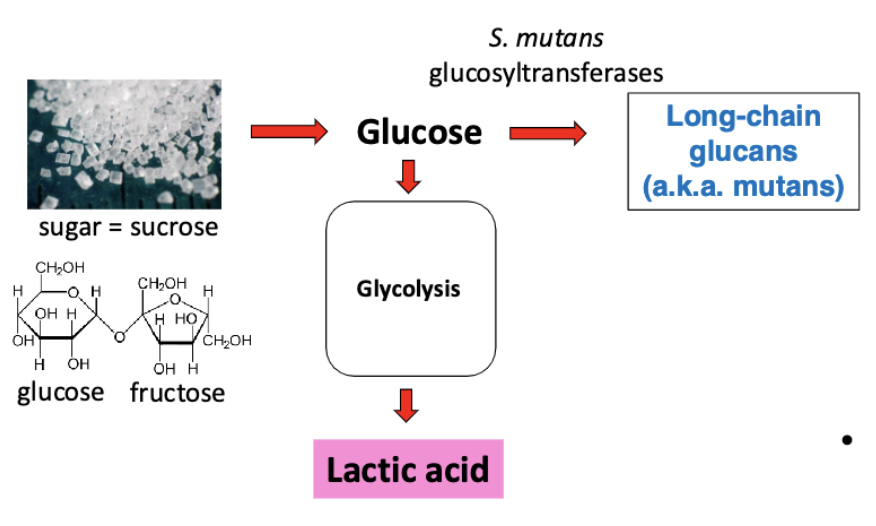
Streptococcus mutans is a major factor in dental caries because of which of the following reasons? List all TRUE answers.
A. It is a Gram+ bacterium.
B. It is a facultative anaerobe.
C. It ferments sucrose and other sugars to lactic acid.
D. It produces glucans that allow bacteria to form biofilms on the tooth surface.
C and D (though all are true characteristics)